Civil War Casualties in County Limerick 1922-1923
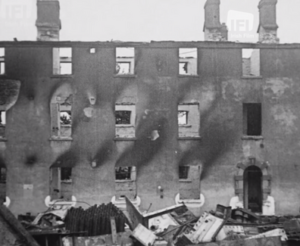
By John Dorney
This article is part of an ongoing project to count the dead of the Irish Civil War of 1922-23. It has been preceded by studies of the death tolls in counties Dublin, Tipperary and Cork.
By my count, compiled from a range of sources, County Limerick saw a minimum of 94 deaths from combat and political violence between January 1922 and September 1923, when the final Civil War related death took place in the county.
Of the dead, forty-four were members of the Free State’s National Army, twenty nine were anti-Treaty Republicans (twenty seven IRA, one Fianna and one Cumann na mBan member), twenty were civilians and one was a member of the Royal Irish Constabulary. A full list of casualties in County Limerick with names, dates and sources can be viewed here.
At least 94 people died in County Limerick due to Civil War violence.
The ninety four deaths caused by Civil War violence in County Limerick contrast with 121 confirmed fatalities in the War of Independence in the county from 1919-1921.[1]
A Summary of the Civil War in Limerick
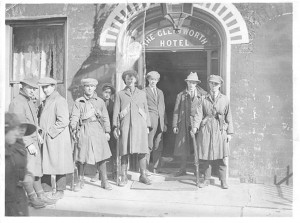
The IRA in County Limerick was split down the middle over the Anglo-Irish Treaty, with East Limerick under Donnacha O’Hannigan pro-Treaty, West Limerick under Gearoid McAulliffe anti-Treaty and the Mid Limerick Brigade around the city split, despite their Officer Commanding Liam Forde taking the anti-Treaty side.[2]
County Limerick played a pivotal part in the lead up to and in the opening months of, the Irish Civil War. Limerick city, the western ‘hinge’ of a line held by the anti-Treaty IRA across the southern province of Munster became a flashpoint as early as March 1922 when an armed stand-off developed there over which faction, pro or anti-Treaty, would take over the garrisons abandoned by the departing Royal Irish Constabulary and British military.
Fighting between pro and anti-Treaty factions almost broke out in Limerick as early as March 1922.
While open fighting was narrowly averted then, there were six deaths in Limerick up to June 1922. Two of the killings were effectively holdovers from the conflict against the British – a loyalist named Peter Switzer who was shot dead in January, in an apparent revenge killing, and a ‘Black and Tan’ RIC constable named Lauchlan McEdward who was killed in an attack on the soon-to-be-disbanded police in February.[3]
However, these were soon overtaken by violence caused by the Treaty split. An anti-Treaty Volunteer was killed in an exchange of fire at Broadford on 9 April with pro-Treaty troops and three more anti-Treaty IRA members were killed in accidental shootings and explosions while garrisoning positions in Limerick city.[4]
Although the formal beginning of the Civil War is considered to have begun with shelling of the IRA Executive at the Four Courts on on 28 June 1922, there was something of false start in Limerick as anti-Treaty leader Liam Lynch attempted to negotiate a local truce with pro-Treaty commander, Donnacha O’Hannigan.
Once hostilities did break out in Limerick on 11 July, however, Limerick city saw fierce fighting for nine days before the anti-Treaty IRA abandoned the barracks they were holding and retreated south from the city. This fighting, which involved up to 700 anti-Treaty fighters and ultimately nearly 2,000 pro-Treaty troops, produced at least twenty six dead: nine National Army soldiers, five anti-Treaty IRA Volunteers and at least twelve civilians.[5]
Limerick city and County saw fierce fighting for a three week period in July and August 1922. Well over half of all Civil War deaths there occurred then.
There followed another two weeks of sustained fighting in the south and west of the County, most notably around the towns of Bruff, Bruree and Kilmallock, which sat astride the main road towards Cork, as the pro-Treaty National Army attempted to push south but were blocked by anti-Treaty IRA units from counties Cork and Kerry as well as Limerick itself.
There was also large scale fighting, as local Limerick anti-Treaty IRA units, attempted to impede the passage of National Army troops along the road leading out of Limerick city towards Kerry, around the towns of Patrickswell, Adare, Rathkeale and Newscastlewest.
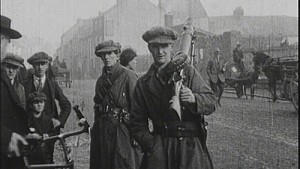
Most unusually for the Irish Civil war, this fighting involved large numbers of combatants and saw widespread use of artillery by the National Army and of armoured vehicles by both sides. At some points trench lines and fortified houses formed a kind of front line, a feature not seen elsewhere in the conflict.
However, superior weight of numbers and equipment on the part of the pro-Treaty forces was eventually decisive and the National Army under Eoin O’Duffy finally took Kilmallock on 5 August. Some sharp fighting in Newcastlewest, in which the anti-Treaty IRA was again forced from that town on 7 August, marked the end of the war’s conventional phase in County Limerick.
There might have been further resistance to their advance south, but seaborne landings by National Army troops on the south coast at Fenit, Kerry, on 2 August, and near Cork city on August 8 caused the anti-Treaty units from those counties to make a hurried retreat from Limerick to their home counties.
The fighting in the Limerick countryside produced at least twenty nine deaths and many more wounded in late July and early August 1922.
While neighbouring counties, notably Tipperary, Cork and Kerry saw the death toll spiral in the following months, as the anti-Treaty IRA embarked on a determined guerrilla campaign, this did not occur in County Limerick. There were very few deaths there in combat after mid August 1922 and only a small number from assassinations, executions and accidents.
Well over 60 per cent of the Civil War deaths in County Limerick, fifty three out of ninety four, occurred in a three and half week period from 11 July, when fighting broke out in Limerick city to 7 August, with the fall of Newcastlewest. Only five people died violently in the county in September 1922, followed by nine in October, one in November and five in December. A mere nine people were killed in County Limerick due to Civil War-related violence in all of 1923, and five of these were firearms accidents among National Army soldiers.
There was no sustained guerrilla campaign in Limerick and casualties fell off dramatically after mid August 1922.
There were a number of reasons for this rapid decline in violence after August 1922. One was the withdrawal of the anti-Treaty IRA units from elsewhere, who had done much of the fighting in the county, back to their own home areas in mid August. A second was the large National Army garrison in Limerick city for the rest of the war, centred around former Limerick IRA commander Donnacha O’Hannigan.
And a third factor was anti-Treaty IRA columns from Limerick, after their defeat in July and August 1922, tended to drift away from the county into other localities.
For instance, Liam Forde commander of the mid Limerick Brigade, after the fall of the last anti-Treaty outpost in Limerick at Newcastlewest, led his men to counties Cork and Tipperary, where they ‘wandered around’ and finally linked up with an IRA column in South Tipperary at Fethard. [6]
As it was, apart from some sporadic attacks on pro-Treaty troops in Limerick city, the only really active unit of anti-Treatyites in Limerick was a column, first under Dick Coleman and then, after his arrest, Seán O’Carroll, which was based in the Silvermines Mountains, around the Castleconnell area.
This ‘Mid Limerick Flying column’, was composed of fifty six men, of whom thirty lived on the run in hillside dugouts and safe houses, and was active in counties Limerick, Clare and Tipperary. However, most of its actions were non lethal operations such as destroying road and rail bridges to block communications and attempting to levy a tax (especially a purported dog license) on the local people to support the Republican cause.[7]
National Army Intelligence reported on 9 February 1923, that in Limerick there were, ‘Individual armed Irregulars, about 10, at large in the Kilmallock district, but not so active. The most important East Limerick Irregulars have joined the South Tipperary and North Cork Columns. The latter column is frequently billeted in Castletownroche, Doneraile district, Cork, outside the boundaries of the Limerick Command.’ And on 23 February they reported that in Limerick that ‘Seán Carroll’s Irregular column has been demobilised’. [8]
Liam Forde recalled that he ‘gave up fighting’ on 10 February 1923 following a Pastoral released by the Irish Roman Catholic Bishop’s condemning the IRA and its activities but remained on the run in County Clare until 1924. ‘The whole thing fizzled through immediately. We were broken up and that. Most of the men were captured. There was no further activity’. [9]
The final death in County Limerick due to combat, as opposed to accident, occurred on 14 April 1923 when National Army soldier Timothy McCarthy of Newcastlewest was killed in what the military reported as ‘Fight at Collin’s house Meencheala, between Brosna and Newcastewest, [in which] one private Tim McCarthy was shot dead and an irregular, Jeremiah Foley was shot and badly wounded.’[10]
Thus, despite quite fierce fighting at the outset, the Civil War in County Limerick had, in terms of lethal violence, fizzled out well before Frank Aiken formally called a halt to it with the IRA Dump Arms order in May 1923.
The Dead
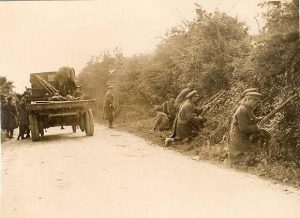
An indicated above, of the ninety four dead, forty four were National Army soldiers, twenty nine were anti-Treaty Republicans (twenty seven IRA, one Fianna and one Cumann na mBan member), twenty were civilians and one was a member of the Royal Irish Constabulary.
Limerick is unusual in Civil War terms in that many of the combatants killed on both sides were not native to the county. Typically, in Cork, Kerry and Tipperary for instance, almost all the anti-Treaty fighters killed were active in their own counties, whereas National Army troops were typically from elsewhere, especially from Dublin. This was down to the anti-Treaty forces usually being local IRA units whereas the National Army, a force centrally recruited by the Provisional Government, was sent wherever it was needed.
In Limerick a plurality of the dead on both sides were from the county: fifteen pro-Treaty and fifteen anti-Treaty fighters. However about 60 per cent of the pro-Treaty dead were from elsewhere, five each from Cork, Kerry and Clare, three each from Dublin and Galway and the remainder from other counties and one from England. The anti-Treaty dead included four men from Cork, two from Kerry and two from Clare.
Most of the dead were male combatants, On the anti-Treaty side predominantly from Limerick, on the pro-Treaty side also from Cork, Kerry and other places.
Those killed in Limerick (as elsewhere) were overwhelmingly male; only five women and girls being killed. Of these, only one, Margaret Ada Hartney, a Cumann na mBan member and wife of IRA officer Michael Hartney, killed by an artillery shell in Newcastlewest, could be classed as a member of a fighting organisation. [11] Three women were killed in the crossfire of the fighting in Limerick city and another, Kate Hare, aged seventeen, was shot dead by unknown assailants on Christmas Eve 1922 in Limerick city.
Of the twenty civilians killed, at least fifteen died in the crossfire of armed engagements, twelve in the fighting in Limerick city in July. It was not common for either side to target civilians deliberately. The IRA in Limerick assassinated one man, Peter Switzer, an alleged loyalist, in January 1922, but did not kill any civilians deliberately during the Civil War proper. The National Army killed five civilians in Limerick, but here again, this was usually not the result of deliberate targeting.
Three were shot dead at roadblocks when they ‘failed to halt’, another shot by a drunken soldier in a pub row and only one, a ‘civil prisoner’, Michael Buckley could be said to have been deliberately killed. He was shot dead on 6 November in Limerick Prison by National Army troops for ‘signalling to political prisoners’.[12]
This contrasts with War of Independence in the county, during which the IRA executed seven civilians as informers[13] and Crown forces also regularly killed civilians in reprisals.[14]
Limerick therefore conforms to a Civil War pattern in which civilians were targeted far less often than they had been during the war against the British. However, even by Civil War standards, violence against civilians was low in County Limerick. By contrast with Limerick’s twenty civilian deaths, seventy two were killed in Dublin and sixty one were killed in Cork. Tipperary saw eighteen civilian deaths, but unlike Limerick, many of these were deliberate killings rather deaths of those caught in the crossfire.
In County Kerry, where the guerrilla phase of the Civil War was far more ferocious than it was in Limerick, the dead were still overwhelmingly combatants. Only twelve out of the one hundred and seventy two dead there were civilians.[15]
Deaths in action and accident
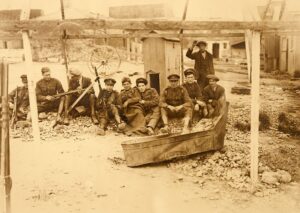
Of the forty four National Army soldiers killed in Limerick, twenty six were killed in action; that is while in combat with an armed enemy. That their deaths were somewhat more than those of their foes should not surprise us, as this is the case in most other counties also. Free State troops had to take to the offensive and attack fortified positions. Indeed, the surprising thing is that their losses were not higher.
Overwhelmingly, in all except fives cases, pro-Treaty deaths in action occurred between 11 July and 11 August 1922, during the intense period of fighting in Limerick. However, another seventeen soldiers died by accident, mostly due to negligent discharge of firearms by either themselves or their comrades.
National Army soldiers died primarily due to the combat of July and August 1922 or in firearms accidents. Anti-Treatyites predominantly due to combat
This is sadly typical of the National Army across the country, where poor standards of training among the hastily recruited army led to as many as a third of their death being self inflicted. According to James Langton’s catalogue of Free State dead, Forgotten Fallen, out of around 800 National Army dead, 480 died by enemy action, while 213 died in firearms or other accidents.[16]
The anti-Treaty IRA saw far fewer of their men (five) die by accidents, but significantly, four of these occurred before the start of fighting in July 1922 and the remaining case occurred in Newscastlewest in August, just before fighting broke out there. When the IRA, equally as poorly trained as their pro-Treaty enemies, were garrisoning posts and constantly around loaded weapons, they were just as accident prone. Guerrillas, whose arms were often hidden or dumped between operations, were far less likely to die by accident.
Of the eighteen anti-Treaty volunteers killed in action in Limerick, almost all (fifteen) died in the combat of July and August 1922, five in Limerick city, four in Newcastlewest and six in the fighting around Kilmallock. That only three died in combat thereafter shows the limited nature of subsequent Civil War operations in Limerick.
Killing of prisoners
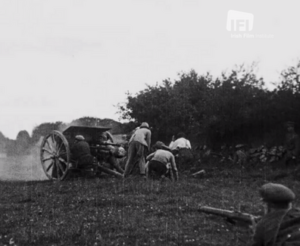
The Irish Civil War, particularly in its latter stages, was characterised in many places by cycles of executions and assassinations. In Dublin and Kerry in particular, the majority of anti-Treaty dead were either executed or killed while prisoners. However this occurred only to a limited extent in County Limerick.
John O’Callaghan writes that the anti-Treatyites executed eight National Army soldiers in two separate incidents in the July fighting, near Killmallock at Bruff and Bruree on July 23. [17] However, this assertion appears to depend on one disputed press report. The pension files of the soldiers in question, by contrast, state that they were killed in action. The file of Cornelius O’Sullivan, for instance, who was killed along with three others near Bruff, states that ‘these four were the advance or scouting party. They did not know the district and came under fire from the irregulars, in which they were killed’.[18]
While there were a small number of cases of the killing of prisoners in Limerick, this was not common there, as it became in other counties.
Moreover, another contemporary press report states that the four were killed in an ambush, caught by machine gun fire while advancing up a ‘hollow lane’.[19] While both mention that the dead were stripped of their boots, neither say anything about them being killed after being taken prisoner.
In the other incident on the same day, in which another four soldiers were killed, the pension of Daniel O’Mahoney states: ‘A small body of troops came upon an outpost of irregulars whom they immediately attacked. The irregulars fought a rearguard action and drew Lt. Power’s party into the irregulars’ main position, where Lieutenant Power, Lieutenant Walsh, Privates O’Mahoney, Murphy and Carey were killed.’ [20] Based on this evidence it seems best to assume that the men were killed in combat.
This is not to say that the Civil War in Limerick was a gentlemanly affair. Four anti-Treatyites were killed while prisoners. Two, Harry Brazier and James Foley were shot ‘resisting arrest’ or ‘trying to escape’. Michael Danford was shot in Limerick jail and another Aeneas Lane, died allegedly as a result of severe beating at the hands of National Army troops.[21]
Two more men, Cornelius McMahon and Patrick Hennessy, both of Clare, were formally executed by firing squad in Limerick Prison on 20 January 1923.[22] However, these figures (six killed) pale in comparison with, for instance, events over the county border in Kerry, where, in March 1923 alone, twenty one anti-Treaty prisoners were killed in revenge for the deaths of five National Army soldiers; or Dublin, where eighteen men were officially executed and another twenty five summarily executed or assassinated during the Civil War by Free State forces.
On the other side there was only one clear-cut case of the assassination of an unarmed National Army soldier, Lieutenant Joseph Hanrahan, who was shot with revolvers and mortally wounded while walking with girlfriend and friends on Roxborough Road in Limerick city on 17 October 1922. [23] There was also a case, however, of a soldier named William O’Brien who was alleged to have died being ‘ill-treated’ while a prisoner of the anti-Treatyites.[24]
The relative lack of killing or prisoners in Limerick was not due to a lack of opportunity on either side. In the fighting in county Limerick in July 1922 the anti-Treatyites took a significant number of pro-Treaty prisoners, including seventy six on one day, all of whom they later released unharmed.[25]
On the other side, by the end of July 1922, Limerick’s prison was so overcrowded that 550 anti-Treaty prisoners had to be transferred by sea to Dublin to alleviate conditions. Nevertheless the institution still held over 600 prisoners in February 1923, indicating that well over 1,000 anti-Treatyites were imprisoned in County Limerick. [26]
This is a necessary reminder that the Irish Civil War for all of its horrors, was a low intensity conflict, a ‘police action’ in British Army parlance, in which arrest was far more common than violent death.
Civil War Death toll
While not pretending to be a definitive death toll, this project is inching us closer to a count of how many people died in the Civil war, how and where. See Appendix Below.
What we are finding is that, contrary to the long held conventional wisdom, in most counties, including the most violent ones, the death toll from the Civil War seems to have been significantly lower than in the preceding War of Independence. This is somewhat balanced out by the fact that in some other ‘quiet counties’ in 1919-21 such as Sligo, Wexford and Kildare the Civil War saw far more violence than the struggle against the British.
The death toll of the Irish Civil War, when finally calculated, is unlikely to exceed that of the War of Independence, contrary to what is often claimed.
Research seems to be showing that it was far more common for National Army soldiers to be killed in combat or by accident in the Civil War than to be assassinated or executed. And while in some places there was widespread killing of anti-Treatyite prisoners, this varied considerably in severity by county. Civilians were also rarely deliberately targeted by either side in the Civil War, unlike the preceding conflict.
Nevertheless it remains to be seen if the final death toll of the Civil War matches, let alone exceeds, the circa 2,000 deaths counted from 1919 up to December 1921. This total is admittedly an all-Ireland one and if those killed in Northern Ireland in the first half of 1922 are counted along with the dead of the southern Civil War, then the toll of the violence of 1922-23 would probably also total about 2,000 dead.
As its stands though, with ten counties out of twenty six covered by various researchers, the confirmed death toll from Civil War violence so far stands at 1,069. While this is a minority of counties, it does cover the most populous counties and those with the most intense Civil War violence.
If the fatal casualties turn out to be somewhat lower than previously thought however, this should not blind us to the social and emotional trauma caused by the Civil War. As anti-Treaty prisoners in Limerick stated in February 1923, the Civil War was ‘an era of vendetta and insane hate’ from which ‘for generations to come, Ireland will be rent by feuds and factions’.[27]
So it was to prove.
Appendix I: Civil War dead by county where available
Dublin, 258
Cork, 220
Kerry, 172
Tipperary, 128
Limerick 94
Sligo, 54
Wexford, 50
Kildare, 45
Kilkenny 26
Offaly, 22[28]
Total so far: 1069.
Appendix II Casualties in County Limerick
RIC: 1 killed
National Army: 44 killed
of whom
26 killed in action
17 by accident
1 assassinated
IRA
29 killed
Of whom
18 killed in action
5 accidents
4 killed while prisoners
2 formally executed
Civilians: 20 killed
15 in crossfire (12 in city fighting)
1 by IRA
4 by NA
Total 94 killed
Population of Limerick 1911 143,069
References
[1] Eunan O’Halpin, ‘Counting Terror Bloody Sunday and the Dead of the Irish Revolution’, in David Fitzpatrick (ed.), Terror in Ireland: 1916-1923 (Lilliput Press: Dublin, 2012), p. 152. Note the 94 deaths here do not include a number of unconfirmed reports of fatal casualties in Limerick. If counted, these would bring the Civil War death toll up to over 100.
[2] For a discussion of the Treaty split in the IRA in the County see John O’Callaghan, Limerick: The Irish Revolution, 1912-1923 (Four Courts: Dublin, 2018), p. 98.
[3] Special advances to widows of members of Royal Irish Constabulary murdered on duty, memorandum, 23 Aug. 1922 (National Archives United Kingdom [NAUK], Home Office [HO] 144/22334/010020). Thanks to Aaron O Maonaigh for this citation.
[4] For Peter Switzer, a Protestant, aged 75, shot and wounded while attending sister’s funeral at Castletown near Pallaskenny, Co. Limerick. See John Lucey, ‘The shooting of Peter Switzer’, North Munster Antiquarian Journal, 53 (2013), pp 237-240; For McEdward see John O’Callaghan, Limerick: The Irish Revolution, p.102; Richard Abbot, Police Casualties in Ireland 1919-1921 (Mercier: Cork, 2019), p. 356. For the incident at Broadford, see Padraig Óg Ó Ruairc, Battle for Limerick City (MercIer: Cork, 2010), pp 50-1 The three accidental deaths were Fianna Éireann Lieutenant Thomas Slattery, Military Service Pension Application [MSPA], (Irish Military Archives [IMA], Military Service Pensions Collection [MSPC], DP/5715l); IRA Volunteer Michael O’Neill, MSPA (IMA, MSPC, DP/2783) and anti-Treaty IRA member, Michael O’Connell of Boherbouy, killed in an explosion at grenade factory in Limerick city. Three others were injured. Ó Ruairc, Battle for Limerick, p. 51.
[5] For The numbers of troops engaged see Michael Hopkinson, Green Against Green: The Irish Civil War (Gill & MacMillan: Dublin, 2004) pp 147-149; for casualties, MSPC files, The Last Post National Graves Association, (1985), The Last Post, New York, NGA., Ó Ruairc, Battle for Limerick, pp 141-142; James Langton, Forgotten Fallen: National Army soldiers killed in action during the Irish Civil War (Kilmainham Tales: Dublin, 2019): Also press reports here
[6] Liam Forde Military Service Pension Collection (MSPC) file MSP34REF43635 Liam Forde
[7] See Seán O’Carroll, MSPA (IMA, MSPC, MSP/34/REF/4167)
[8] Irish Military Archives (IMA), reports to the Executive Council 1923 (IMA, MIPR-02-42)
[9] Liam Forde MSPA MSP34REF43635
[10] Report to Executive Council, 14 April 1923, Irish Military Archives (IMA), CREC-02) Timothy McCarthy MSPC 3D255. Four National Army soldiers were killed accidentally after this point however.
[11] Though she was doing non combatant work. (see Moss Hartnett, Victory and Woe, The West Limerick Brigade in the War of Independence, UCD Press, Dublin 2015), p. 133) Pension File MD1893. Margaret Hartney was engaged in first-aid and kitchen duties in the ‘Adare Arms Hotel’ [Dunraven Arms Hotel] which had been turned into a hospital by the IRA. On 4 August 1922, Michael Hartney and references on file claim that a 16lb or 18lb artillery shell fired by the National Army hit the hotel killing Margaret Hartney instantly. Michael was wounded in the arm, shot, at Adare on Aug 4. His pension.(IMA, MSPC, MSP/34/REF/11113)
[12] Irish Times, 8 Nov. 1922.
[13] Padraig Óg Ó Ruairc, ‘Spies and Informers Beware, The Killing of alleged civilians informer during the Irish War of Independence’
[14] O’Callaghan, Limerick: The Irish Revolution, p. 83.
[15] For Dublin, Cork and Tipperary see links above to Irish Story articles, for Kerry, see Tom Doyle, The Civil War in Kerry (Mercier: Cork, 2008), pp 328-331.
[16] James Langton, Forgotten Fallen, pp 7-8. The remainder died of disease or ill health.
[17] O’Callaghan, Limerick: The Irish Revolution, pp 110-111. The soldiers in question were Corporal Cornelius Sullivan, or Cork Lieutenant Thomas Power, of Cork Private Timothy Murphy of Kerry and Private John Quirke, of Cork killed on July 23 and Daniel O’Mahoney (Cork) Lieutenant Walsh and Privates Timothy Murphy , Kerry,(2D113) and Patrick Carey (Cork 2D41) killed in the same incident. 2D204
[18] Cornelius O’Sullivan Pension File 2D152.
[19] Available online here http://www.limerickcity.ie/media/07%2029%201922%20quirke,%20murphy,%20sullivan.pdf
[20] It does go on to say that ‘Detailed inquiries have been made, but owing to the system of records at that time and the subsequent shifting of officers and men, it has not been possible to secure a detailed account of the affair’, suggesting that there is some ambiguity about the incident, but again, nothing to suggest an atrocity. Daniel O’Mahoney pension file 2D204.
[21] Pension files Michael Danford DP60, Also, The Last Post p.136 states that he was ‘executed in Limerick jail’. Harry Brazier Pension File DP448, , ‘Murdered in Limerick jail’ (The Last Post, p. 136); James Foley (Irish Times 18 Nov. 1922) James Foley was shot dead on 27 October 1922 at Dock Road, Limerick during the Civil War. He was attempting to escape from National Army custody when he was shot. Pension File DP3605. Aeneas Lane, DP23767.
[22] Pension files Cornelius McMahon, DP7391 Patrick Henessey, DP4352.
[23] Joseph Hanrahan, Pension File 2D200. Also, Langton, Forgotten Fallen, p. 160. Incidentally, two men, Gerard Fitzgibbon and Joseph O’Connor were arrested and tried by court martial for the killing but escaped in December from the military barracks in Limerick city. Limerick Chronicle, Dec. 1922.
[24] O’Callaghan, Limerick: The Irish Revolution, p.111
[25] See Hopkinson, Green Against Green, p. 152. It is not easy to quantify how many pro-Treaty soldiers were taken prisoner in this period, but Liam Lynch later referred to ‘hundreds’.
[26] Dublin Corporation Inquiry into prisoners, Oct. 1922 (National Archive of Ireland, Department of the Taoiseach, TAOIS 1369 , Box 3); O’Callaghan, Limerick: The Irish Revolution, p. 113.
[27] O’Callaghan, Limerick: The Irish Revolution, p. 113.
[28] John Dorney, ‘Casualties of the Irish Civil War in Dublin’; Dorney, ‘Casualties of the Civil War in Tipperary’; idem, ‘Casualties of the Civil War in County Cork’; Aaron Ó Maonaigh, ‘The Killurin Ambush and the Civil War in Wexford’; Doyle, The Civil War in Kerry, pp 328-331; Michael Farry, The Aftermath of Revolution: Sligo 1921–23 (UCD Press; Dublin, 2000); Phillip McConway, ‘The Civil War in Offaly’, Offaly Tribune, 2 Jan. 2008; James Durney, The Civil War in Kildare, pp 14-15; Eoin Swithin-Walsh, Kilkenny in Times of Revolution, 1900-1923, Merrion Press, Kildare, (2018), p. 249.